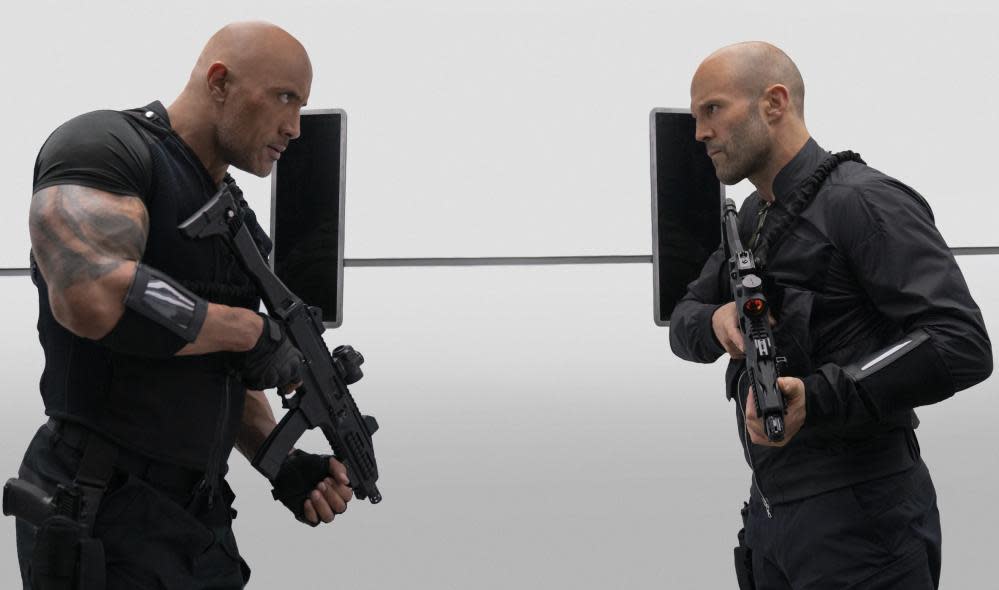Fastest & Furiousest: how Hobbs & Shaw expands the $5bn franchise

In the comedown off the adrenaline high resulting from The Fate of the Furious, the eighth and most recent entry in the franchise of dizzyingly lucrative pedal-to-the-metal blockbusters, the future of the series seemed dicey. These films had claimed box-office supremacy by one-upping themselves with the skill and self-knowledge of the great kung fu epics, always saving their wildest moves for the moment of maximum impact. But the sequel dubbed F8 didn’t leave a whole lot of road on which to put the rubber; having sped just ahead of shattering ice in pursuit of a nuclear submarine, having jumped a luxury four-door vehicle out of one skyscraper and through the windows of the neighboring tower, where could they go? (Aside from space.)
Related: Fast & Furious: Hobbs & Shaw review – a fervently brainless delight
Enter Hobbs and Shaw, a spinoff pairing two fan-favorite antagonists from the primary diegesis and sending them off on an odd-couple adventure all their own. The macho charm of Dwayne “The Rock” Johnson (as diplomatic security service agent Luke Hobbs) and the stone-faced tough-guy act from Jason Statham (as special forces officer-gone-rogue Deckard Shaw) proved a winning combination this past weekend, as they raked in a staggering $180m take in worldwide ticket sales. But the causes for this film’s success run deeper than the nitroglycerine chemistry between its muscular leads. The true strength of Hobbs and Shaw, the secret to extending a film universe seemingly nearing its limit, is its willingness to loosen up. In throwing out the rule book and relaxing its own mythos, the series has opened up a world of narrative possibility just waiting to be.
The absence of series lead Dom Toretto and his “family” of stick-shift daredevils could have been sufficient to set Hobbs and Shaw apart from the installments that preceded it. Director David Leitch (a proven wizard of hyperkinetics in his capacity as director of Atomic Blonde and Deadpool 2) went deeper into the fabric of the film to distinguish it, however. The Fast and Furious films proper, for all their outrageous stunts in brash defiance of gravity, have hewn to some spiced-up version of reality. They’re about human beings doing human things like driving cars, shooting guns and punching each other – they’re just really, really good at it. Hobbs and Shaw announces its declaration to leave the limits of plausibility behind early on, when villain Brixton (Idris Elba) makes his first appearance. He’s been outfitted with “cybergenetic” implants imbuing him with powers beyond those of any human, going so far as describe himself boastfully as “black Superman”. In the previous films, the fantastical elements would’ve made him stick out like a sore thumb, but he fits right in within the anything-goes realm of this IP detour.

His amplified strength, speed and agility represent a rewriting of the code by which this series has heretofore operated, and might just be the series’ saving grace. Allowing characters to do whatever kookoo nonsense they please (so long as it makes for bombastic widescreen spectacle) doesn’t run the risk of shattering our suspension of disbelief, because the series never had much interest in courting it in the first place. The grand Fast and Furious project has only now begun to live up to the totality of its promise, tricking out its characters the same way the characters trick out their hot rods. For a franchise with unfettered idiotic fun as its raison d’être, setting parameters on that fun did nobody any favors.
To this same effect, the series has freed itself from the restricting tethers of its own history. Some diehard fans cried foul upon hearing the news that Statham’s Deckard Shaw would be welcomed into the ranks of the main crew, considering that the character had killed good guy Han Lue (Sun Kang) in the earlier Tokyo Drift. The #JusticeForHan hashtag gained a bit of traction on Twitter, though this critic would contend that Hobbs and Shaw’s willful ignoring of this storytelling wrinkle keeps it fleet-footed and moving. At a time when the Marvel-industrial complex eats up approximately half the run time of each new feature meticulously positioning it in connection to their last 30 releases, a film willing to do and be its own thing comes as a tonic, nitpicking be damned.
As popcorn blockbusters become increasingly serious business in the estimation of the public, muscling their way into Oscar races and critics’ top-10 lists and other venues of artistic legitimacy, Hobbs and Shaw dares to not take itself so damned seriously. Though its explosions may be several stories tall, its ambitions are humble. Statham and the Rock, manly-men they are, know that true bravery means being unafraid to let a silly movie be a silly movie.

